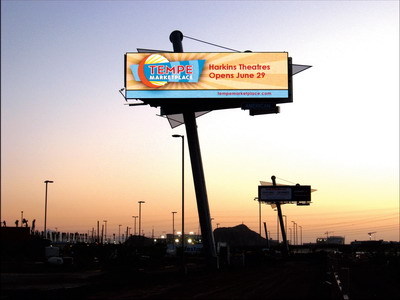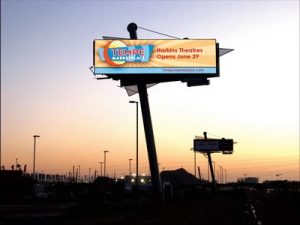In the early 1990s, a hot buzz phrase of the advertising community was “place-based media.” I loved it, latched onto it and still use it.
Though many media share the generalized term, I find “place-based” perfectly defines the use of a digital sign, which is targeted toward a specific audience. I think it clearly defines the appropriate usage of a programmable, digital, advertising display.
As digital-display technology matures, the greater advertising community is finally embracing digital displays as legitimate media. I keep waiting for a re-emergence of the old phrase, but, at least in my world, I seem to be the term’s only remaining proponent.
Instead, the ad industry calls it “digital.” I hear a continual buzz around the concept – digital outdoor, digital signs, digital display, digital media, etc. In any event, I’m thankful for the attention and the opportunity to share in an explosive new direction in advertising.
A few weeks ago, I met with a significant advertising group in NYC that was brainstorming new concepts regarding “digital.” The managing director, who declined to be quoted for this piece, effusively praised the medium’s power. A digital display incorporated in an architectural feature, or as a component of an overall design theme in a retail environment, places advertising in an environment where it is “intrusive” to an audience advertisers want to reach, he gushed. Sounds like a “place-based” medium to me.
Advertisement
The concept of high-resolution, programmable digital signs for retail environments is, indeed, a rapidly emerging industry. Inside and outside malls and individual stores, digital displays are emerging as a critical method for advertisers to reach an audience never before contemplated.
Retail environments increasingly deploy digital-display (mostly plasma and LCD) networks that feature advertising mixed with general, entertainment information. This medium serves as a perfect, point-of-sale opportunity for individual products or as an enticement cleverly placed where potential buyers congregate. Some stores utilize hundreds of these displays. Some retail chains, such as Wal-Mart, have developed extensive networks with highly creative content streams.
Retail-space developers have noted the billboard industry’s conversion of traditional billboard space to programmable digital signs. I know several, savvy retail developers have forged partnerships with outdoor-advertising companies to create specific, place-based media, on the property of the retail development. The concept is a win-win for both the developer and the outdoor-advertising company.
Developers can usually induce the advertising company to pay all, or most, of the display cost. Consequently, they can lasso, at little, or no, upfront expense, a large, high-technology digital display that features the property name and advertises the property’s tenants. The development company can share the expense associated with the displays’ operation and also share revenue. Outdoor-advertising professionals sell advertising to tenants or other parties – and thus save the developer many headaches.
For the outdoor-advertising company, digital displays at a mall or other retail environment expand inventory at desired locations that aren’t normally available. Most display costs lay in the sign’s digital portion, which would typically be paid at any new site development. The cost of the revenue-share relationship is offset, at least in large part, by avoiding the land-lease arrangement, which a new billboard placement typically faces.
One major billboard executive found a secondary benefit to developing a new market within the retail-store industry, which isn’t traditionally a strong, outdoor-advertising buyer. He theorized that stores will be more interested in advertising on the same property where they’re located. With the retail-center display as an anchor, the potential exists to sell ads on other billboards, digital or otherwise, in a package with the retail-center digital sign.
Advertisement
This scalable idea could work in any market. Even where digital signs are highly regulated, communities should work with retail developers because their centers drive huge tax bases. Further, they magnetize growth in adjacent and surrounding areas. The placement of a high-resolution display that shows changing messages in a still-image format, with controlled illumination, can be bartered in exchange for the new development’s positive community impact. Savvy retail developers present the digital-signage component when the center is first proposed to the community.
Every community has a retail-development company, as well as advertising firms (both billboard companies and independent agencies). Creative sign salespeople will seize this winning opportunity.
Even in this difficult economic time, many new retail developments are planned or under construction, and many centers are being redeveloped or redesigned. In either scenario, a new sign, although desired, is frequently the first item cut from the budget. Bringing an advertising entity to the table greatly increases the likelihood of a significant new sign sale, even without a sign budget.
I was involved in a sale to an existing shopping center that had operated for 35 years. The center was in a very high-traffic location in a prominent part of a medium-sized city. I had previously proposed many digital-sign packages for this center, but was always told there was no budget for such expenditures. When I proposed selling ads to the tenants, the concept was downplayed as nearly impossible, given the staff available to do the selling. After many sales pitches, the development knew it would benefit from the sign, but the technology’s cost and complexities made it unworkable.
Later, when the opportunity arose to sell the display to the same center I had courted for two decades, I was less than enthused. But, as the outdoor-advertising industry involvement emerged, suddenly a light went off in my head. The merger of the development industry with the outdoor-advertising industry provided solutions for both parties.
The billboard company received two, new, digital-advertising faces at the best of all locations, where billboards were strictly prohibited. The developer received a very high-profile display, which added to the center’s redevelopment, without the display cost. The outdoor-advertising company, which also programs the sign, sold the ads.
Advertisement
The sign company received a rich, six-figure sale and a long-term maintenance agreement. In other cases, the sign company also has the opportunity to sell a programming agreement.
For most of us, this personifies out-of-the-box thinking, my favorite kind. Bringing disparate parties together, each with its own, unique, value proposition, can generate a high-value sale with an extended, multi-level revenue stream where none existed before.
This new opportunity will present itself now that the creative minds of the advertising industry are focused on our technology. How many other place-based media opportunities exist right under our noses?



 Tip Sheet1 week ago
Tip Sheet1 week ago
 Photo Gallery3 days ago
Photo Gallery3 days ago
 Ask Signs of the Times5 days ago
Ask Signs of the Times5 days ago
 Real Deal2 weeks ago
Real Deal2 weeks ago
 Benchmarks1 week ago
Benchmarks1 week ago
 Photo Gallery5 hours ago
Photo Gallery5 hours ago
 Women in Signs2 weeks ago
Women in Signs2 weeks ago
 Women in Signs1 week ago
Women in Signs1 week ago










